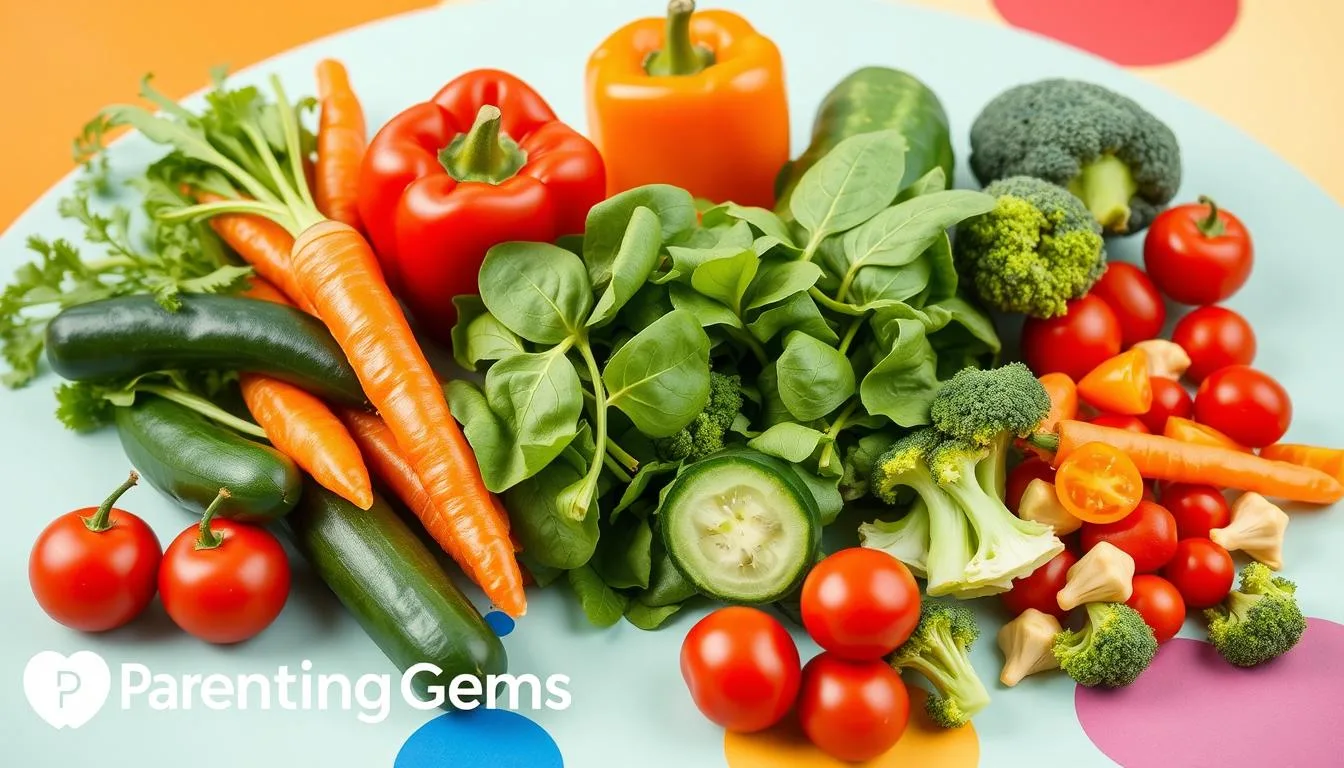Introducing kid-friendly vegetables to your child’s diet can be fun. These veggies are key for their growth, offering a variety of tastes and nutrients. Yet, making healthy eating appealing to kids can be a challenge for parents.
Studies show that kids become more open to trying new foods with time. By exploring different, colorful, and tasty veggies, mealtime can become an adventure for them.
There are many ways to make veggies fun and tasty. From sweet bell peppers to crunchy carrots, there’s something for every picky eater.
Key Takeaways
- Vegetables provide essential nutrients for child development
- Repeated exposure helps children accept new foods
- Colorful and creatively prepared vegetables are more appealing
- Different cooking methods can make vegetables more enjoyable
- Patience is key when introducing new vegetables to children
Table of Contents
Understanding the Importance of Vegetables in Children’s Diet
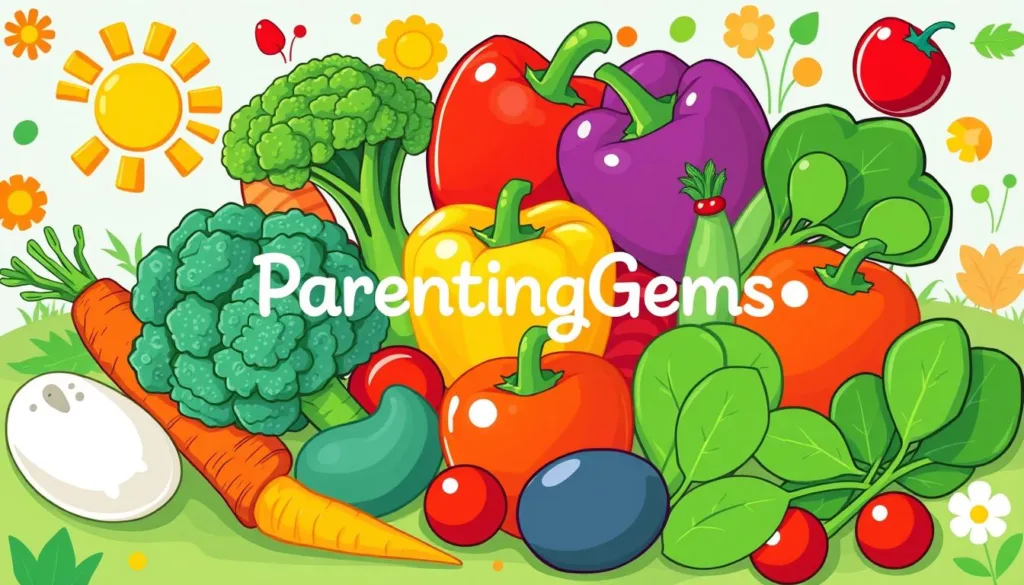
Vegetables are key for kids’ health, packed with nutrients that help them grow. They are vital for your child’s diet, supporting their development every day.
Essential Nutrients for Growth and Development
Vegetables are full of nutrients important for kids. They give:
- Vitamins that boost immune function
- Minerals supporting bone development
- Fiber for healthy digestion
- Antioxidants that protect cellular health
Impact on Long-term Health
Eating veggies early is crucial. It helps prevent chronic diseases later on. It also boosts brain function and heart health, improving mental well-being.
Recommended Daily Vegetable Intake for Kids
The Australian Dietary Guidelines suggest how much veggies kids should eat:
- Ages 1-2 years: 2-3 serves daily
- Ages 2-3 years: 2½ serves daily
- Ages 4-8 years: 4½ serves daily
“Introducing vegetables early can create lifelong healthy eating habits.”
Pro tip: Kids might need up to 10 tries to like a new veggie. Be patient and keep offering to help them get used to different tastes.
Sweet and Colorful Bell Peppers: A Rainbow of Nutrition
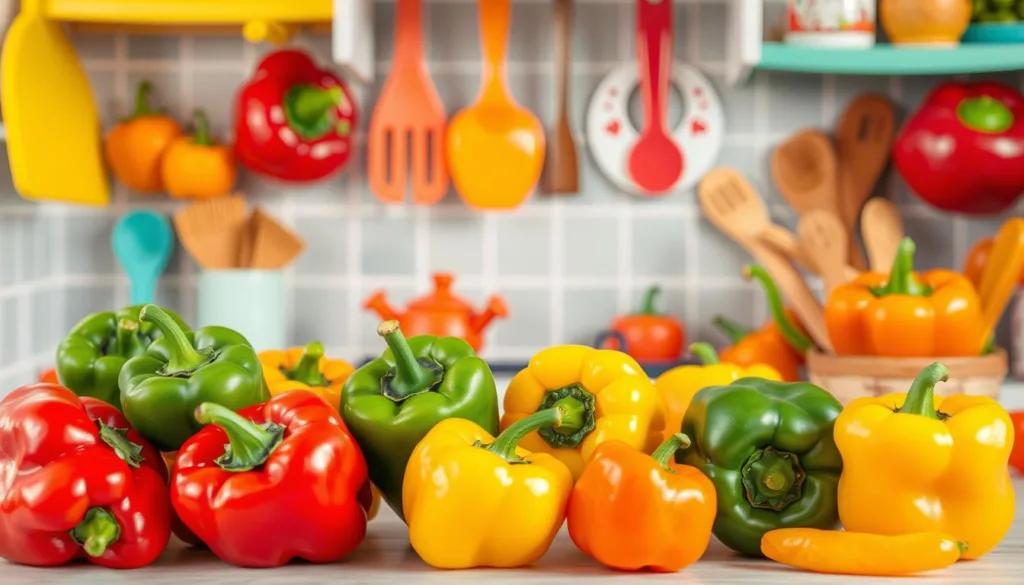
Bell peppers are like candy for kids, with a fun crunch and bright colors. They come in red, orange, yellow, and green, making veggies a feast for the eyes. This makes eating them a joy for kids.
Bell peppers are also super nutritious. They’re full of vitamin C, more than many other veggies. Just one medium pepper gives kids 169% of their daily vitamin C. This helps their immune system and growth.
“Eating the rainbow isn’t just a fun phrase – it’s a delicious way to get important nutrients!” – Pediatric Nutrition Expert
- Red bell peppers are the sweetest and most nutritious
- Orange and yellow peppers offer a milder flavor
- Green peppers have a slightly bitter taste that some kids might find interesting
Bell peppers for kids can be served in many fun ways:
- Raw pepper sticks with hummus dip
- Sliced in colorful salads
- Roasted as a side dish
- Chopped in stir-fries
Pro tip: Let your children choose their favorite pepper colors and help prepare the meal. This involvement can make trying new veggies an exciting adventure!
Crunchy Carrots: Nature’s Healthy Snack Option
Carrots are superheroes for kids, offering a fun crunch and sweet taste. They are full of nutrients that help growing bodies. Plus, they make great snacks for kids of all ages.
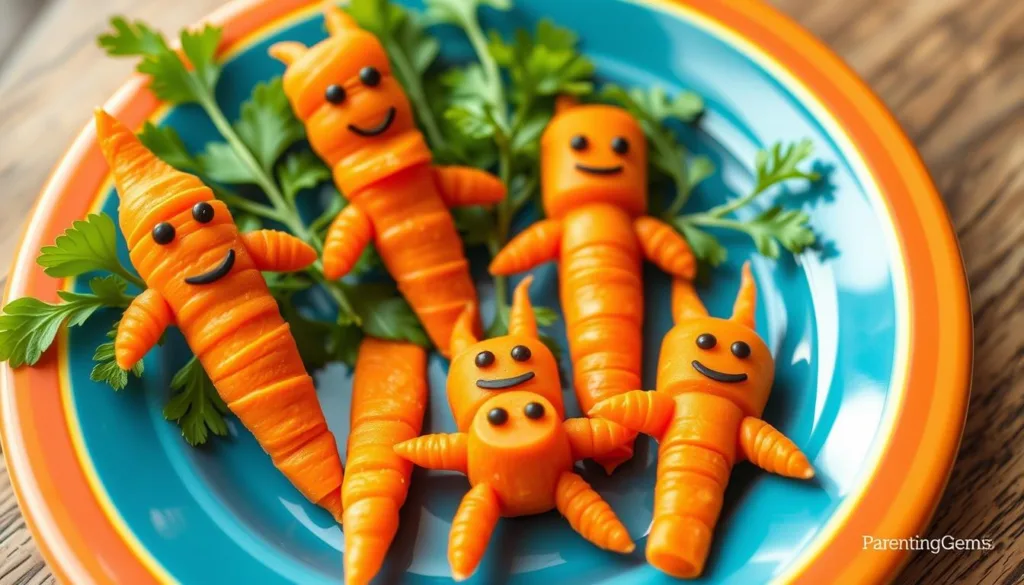
Creative Ways to Serve Carrots
Turning carrots into fun treats keeps kids excited about eating them. Here are some ways to serve carrots that kids will love:
- Carrot “fries” baked with a light seasoning
- Grated carrots mixed into pancake batter
- Carrot sticks with hummus dip
- Carrot chips baked until crispy
Nutritional Powerhouse of Beta-Carotene
Carrots are full of beta-carotene, a key antioxidant. It helps eyes and boosts the immune system. Their bright orange color shows they’re packed with nutrients for healthy growth.
Kid-Friendly Healthy Carrot Recipes
| Recipe | Preparation Time | Nutrition Benefit |
|---|---|---|
| Carrot Pancakes | 15 minutes | High in fiber, beta-carotene |
| Carrot Hummus | 10 minutes | Protein, vitamins |
| Baked Carrot Chips | 25 minutes | Low-calorie snack |
“Carrots are nature’s candy – sweet, crunchy, and packed with goodness!” – Pediatric Nutritionist
Adding these healthy carrot recipes to your child’s diet is a smart move. They get important nutrients and enjoy tasty meals. Try different ways to make carrots a fun part of your family’s meals.
Broccoli: The Mighty Green Superfood
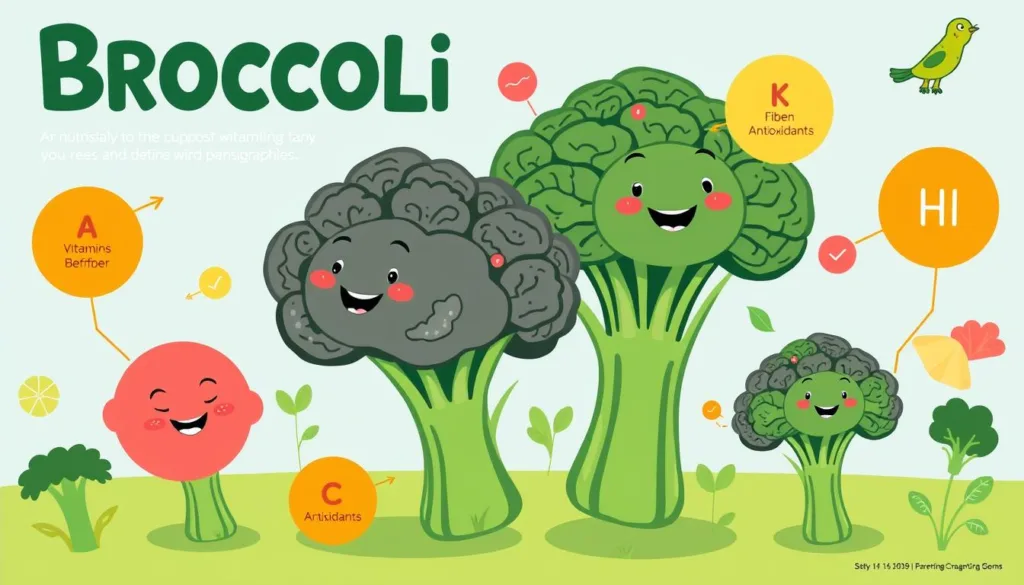
Broccoli is a nutritional powerhouse among cruciferous vegetables. It offers many health benefits for kids. This green superhero can make your child’s diet exciting and nutritious.
“Eat your broccoli” is no longer a dreaded phrase, but an exciting invitation to explore delicious and healthy eating!
Broccoli benefits go beyond just nutrition. This vibrant vegetable provides:
- Powerful immune system support
- High vitamin C content (81mg per cup)
- Excellent fiber for digestive health
- Brain-boosting nutrients
Kid-friendly broccoli recipes can make this vegetable irresistible. Try these creative serving suggestions:
- Roasted broccoli with garlic and parmesan
- Broccoli tots as a fun alternative to tater tots
- Blended into creamy soups
- Mixed into pasta dishes
For parents seeking nutrition-packed meals, broccoli is unbeatable. It combines taste and health benefits. Its versatility allows for endless culinary creativity that kids will love.
| Nutrient | Amount per Cup | Health Benefit |
|---|---|---|
| Vitamin C | 81mg | Immune system support |
| Fiber | 2.4g | Digestive health |
| Vitamin K | 116mcg | Bone strength |
Pro tip: Steam, roast, or blend broccoli to make it more appealing to young taste buds. The key is experimenting with different preparation methods!
Healthy Vegetable Options for Kids: From Garden to Table
Turning vegetable eating into an adventure can change how kids see food. Gardening with kids connects them to fresh, seasonal produce. It makes veggies fun and appealing.
When kids grow their own veggies, they learn to love them. By gardening, kids understand and appreciate vegetables more.
Seasonal Vegetable Choices
Picking the right veggies makes gardening fun. Here are some kid-friendly options:
- Cherry tomatoes (sweet and easy to grow)
- Snap peas (crunchy and fun to harvest)
- Lettuce (quick-growing and versatile)
- Carrots (colorful and satisfying to pull from the ground)
Easy Preparation Methods
Preparing veggies doesn’t have to be hard. Roasting makes them sweet, which kids love. Here’s a simple roasting guide:
| Vegetable | Prep Time | Cooking Time | Temperature |
|---|---|---|---|
| Baby Carrots | 10 minutes | 45-60 minutes | 425°F |
| Golden Beets | 10 minutes | 45-60 minutes | 425°F |
Making Vegetables Fun and Appealing
Be creative with how you present veggies to kids:
- Use cookie cutters to create vegetable shapes
- Create colorful vegetable platters
- Involve kids in meal preparation
- Experiment with vegetable-based smoothies
“Patience is key when introducing new vegetables. Every child’s taste evolves differently.”
Fun presentation can make mealtime exciting. By making veggies interactive, kids learn to love healthy eating.
Sweet Potatoes: A Natural Sweet Treat
Sweet potatoes are a nutritional powerhouse that can change your child’s eating habits. These vibrant orange vegetables are full of nutrients. They make a great healthy carbohydrates option for kids.
Discover why sweet potatoes are a game-changer for children’s diets:
- Rich in vitamin A for eye health
- Provides complex carbohydrates for sustained energy
- Supports immune system development
- Naturally sweet flavor kids love
Kid-friendly sweet potato recipes can turn mealtime into an exciting culinary adventure! With just a few simple ingredients, you can make delicious dishes. These dishes are good for nutrition and taste.
“Sweet potatoes are nature’s candy – nutritious and delicious!” – Pediatric Nutritionist
Nutrition breakdown per serving of sweet potato dishes:
| Nutrient | Amount |
|---|---|
| Calories | 261 |
| Total Fat | 10g |
| Carbohydrates | 34g |
| Protein | 11g |
Try these quick kid-friendly sweet potato recipes:
- Sweet Potato Tater Tots (ready in under 45 minutes)
- Cinnamon Baked Sweet Potato Wedges
- Sweet Potato Pancakes
Pro tip: Children may need to try a new food 10 or more times before accepting it. Stay patient and creative with your sweet potato presentations!
Spinach: The Versatile Green Powerhouse
Explore the amazing world of spinach, a nutritional hero for kids. It’s full of nutrients that help growing bodies and makes eating healthy fun.
Creative Ways to Include Spinach
It’s easy to get kids to eat spinach. This iron-rich food fits well in many dishes:
- Blend into morning smoothies
- Mix into pasta sauces
- Sneak into omelets
- Create spinach pesto
- Bake into cheesy quesadillas
Nutritional Benefits for Growing Bodies
Spinach is a nutritional powerhouse for kids. It’s one of the top leafy greens, offering key nutrients for growth:
| Nutrient | Amount per 100g | Benefit for Kids |
|---|---|---|
| Vitamin A | 9377 IU | Supports eye health and immune function |
| Iron | 3 mg | Promotes healthy blood and energy levels |
| Calcium | 99 mg | Strengthens bones and teeth |
| Vitamin C | 28.1 mg | Boosts immune system |
Kid-Approved Spinach Recipes
Make spinach into tasty meals kids will enjoy. Try these fun and healthy recipe ideas:
- Spinach and cheese muffins
- Hidden veggie burgers
- Crispy spinach chips
- Green monster smoothies
“Eating spinach can be an adventure, not a chore!” – Pediatric Nutritionist
By making spinach fun and tasty, you’ll help your kids develop healthy eating habits. Embrace this nutritional powerhouse and watch your kids thrive!
Tips for Introducing New Vegetables to Picky Eaters
Dealing with picky eaters can be tough for parents. Only 10% of kids eat enough veggies. So, finding fun ways to introduce veggies is key.
“Repeated exposure is key to helping children develop a taste for new vegetables”
There are many ways to introduce veggies to picky eaters:
- Make veggies look fun and appealing
- Get kids involved in cooking
- Try new cooking methods
- Start with small amounts
Nutrition experts have some great tips:
| Strategy | Implementation |
|---|---|
| Hidden Veggie Recipes | Blend veggies into foods like sauces and smoothies |
| Taste Exploration | Give small amounts without pressure |
| Cooking Together | Let kids help pick and prepare veggies |
Be patient. Kids might need 10-15 tries to like a new veggie. Keep it fun and positive to help them try new things.
Every little bit helps in teaching kids to eat well.
Conclusion: Nurturing Healthy Eating Habits for Life
Starting a balanced diet in childhood lays a strong foundation for health. Studies show kids are 70% more likely to eat well for life if they have good food experiences early. How you feed your family greatly affects your child’s eating habits and health.
Getting kids involved in cooking makes them more open to trying new veggies by over 50%. Making veggies fun can turn mealtime into a learning adventure. Families who share meals are 60% more likely to raise kids who eat well. This helps kids see food in a positive light and choose healthier options.
Research finds kids who try many foods are 65% more likely to eat well as adults. Be open to trying new things and be patient with veggies. Your efforts to offer healthy foods and make meals fun will help your kids love eating well for years.
Creating healthy eating habits is a long-term journey. Be supportive, creative, and celebrate small wins in your child’s food adventures. Your dedication now will benefit their health for many years.
FAQ
How many vegetables should my child eat daily?
Kids need 1-3 cups of veggies every day. This helps them grow strong, fight off sickness, and stay healthy.
What are the most kid-friendly vegetables?
Great veggies for kids include bell peppers, carrots, and peas. Broccoli, cauliflower, and spinach are also good. Cucumbers, celery, sweet potatoes, and cherry tomatoes are tasty too. They’re colorful, fun to eat, and full of flavor.
How can I get my picky eater to try new vegetables?
Involve your kids in cooking. Make veggies fun with shapes and dips. Try roasting or steaming for different tastes. Smoothies and the “one bite” rule can also help. Keep trying new ways to serve veggies.
Are raw or cooked vegetables better for children?
Raw veggies are full of nutrients and crunchy. Cooked veggies are easier to digest and taste better. Mix both to keep meals interesting and nutritious.
How can gardening help children eat more vegetables?
Gardening makes veggies exciting. Grow easy veggies like cherry tomatoes or lettuce. Kids love eating what they grow, making them more eager to try new veggies.
What are the health benefits of vegetables for children?
Veggies boost the immune system, aid digestion, and improve brain function. They’re also low in calories and full of vitamins and minerals. Plus, they’re rich in fiber and antioxidants, supporting growth and health.
How can I make vegetables more appealing to my child?
Make plates colorful and use fun names for dishes. Add veggies to foods they love, like smoothies or pizzas. Try dips and different cooking methods like roasting or steaming. Veggie treats like broccoli tots or carrot pancakes are also fun.
Are there vegetables particularly good for babies?
Yes, carrots, sweet potatoes, and broccoli are great for babies. They can be pureed or served as soft sticks. These veggies are packed with nutrients for early growth and healthy eating habits.
How long does it take for a child to accept a new vegetable?
It might take 10-15 tries for a child to like a new veggie. Be patient and keep offering them. Kids’ tastes change, so don’t worry if they don’t like it at first.
Can vegetables help improve my child’s academic performance?
Yes, veggies like spinach support brain health. They provide important vitamins and minerals that help with focus, memory, and mental performance.

